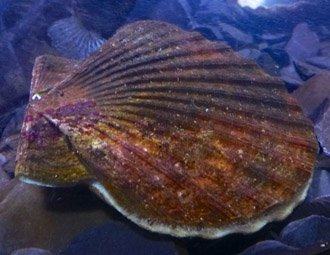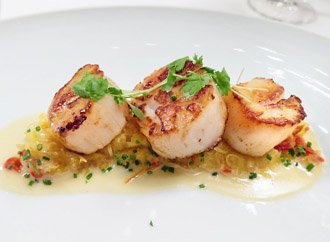Sea Scallops Nutrition facts
Sea scallops, a variety of bivalve mollusks, are harvested for their raw, cylindrical meat. These prized seafood delicacies are renowned for their sweet yet briny and flavorful taste. Their robust, lean meat offers a fine source of protein that is low in both fat and calories.
Scallops belongs to the family Pectinidae and their scientific name is Placopecten magellanicus. They are also called as American sea scallop, Giant scallop, Atlantic deep-sea scallop, or deep-sea scallops.
Atlantic sea scallops are found in the Northwest Atlantic Ocean, from Newfoundland to Cape Hatteras, North Carolina.
 |
| Sea Scallop. Courtesy: Les Chatfield |
Description
Sea scallops are bivalve mollusk that live on oceans bottom (benthic) all around the world, generally at depths from 30 to 100 meters (about 100 to 300 feet).
They have distinctive features in their appearance, typically fan-shaped hard shell that comes in various colors. They reach 20 cm (8 inches) in diameter and can live up to 20 years.
Sea Scallop is harvested for the meat of the large adductor muscle that holds the top and bottom parts of the shell together. Raw, the cylindrical-shaped meat is shiny and usually creamy white or tan, though sometimes slightly pinkish to orange in color.
Biology
Sea scallops grow quickly for the first few years of their life and reach about 6-7 inches in length. They can reproduce by age 2 and have a very fertility rate and usually spawn in late summer or early fall.
Habitat
Grown-up scallops live in clusters known as "beds" along the sandy or gravelly parts of the ocean floor. They feed by sieving phytoplankton or tiny organisms from the water column.
Health advantages of Sea Scallops
Sea scallop, as a mollusk, offers a low-calorie, low-fat white meat. 100 grams of its lean meat contains just 69 calories and 0.5 grams of fat.
Sea scallops are an excellent source of high-quality protein, containing 12.1 grams per 100 grams (22% of the RDI). Protein is essential for cell repair, muscle development, and overall growth in the body.
They are a good source of omega-3 fatty acids, particularly EPA (eicosapentaenoic acid) and DHA (docosahexaenoic acid). Omega-3s are known for their role in supporting heart health, reducing inflammation, and promoting brain function.
Research studies indicate that seafood consumption can reduce the risk of heart attacks, strokes, obesity, and hypertension. Seafood is low in saturated fat and rich in "heart-healthy" polyunsaturated fat, including omega-3 fatty acids. The American Heart Association recommends seafood due to its diverse range of nutrients, essential fatty acids, vitamins, and minerals that play vital roles in the metabolic functions.
Sea scallop meat also provides small but valuable nutrients such as folates, niacin, vitamin B6, thiamin, and riboflavin.
100 g fresh scallops meat meat provides 1.47 μg or 59% of daily-required levels of vitamin B-12. Vitamin B12 plays a crucial role in supporting red blood cell formation, neurological function, DNA synthesis, and overall cell metabolism within the body.
Scallops are an abundant source of essential minerals, including phosphorus (334 mg or 48% of the Daily Intake), selenium (23% of the RDI), iodine, calcium, zinc (8% of the RDI), potassium, and magnesium.
Compared to some other seafood options, sea scallops are relatively low in methyl-mercury, making them a safer choice, especially for pregnant women and young children. The Food and Drug Administration (FDA) recommends that pregnant women consume at least 8 to 12 ounces (about 340 grams) of seafood with low mercury content per week.
| Principle | Nutrient Value | Percent of RDA |
|---|---|---|
| Energy | 69 Kcal | 3.5% |
| Carbohydrates | 3.18 g | 2.5% |
| Protein | 12.1 g | 21.6% |
| Total Fat | 0.49 g | 2.5% |
| Cholesterol | 24 mg | 8% |
| Dietary Fiber | 0 g | 0% |
| Vitamins | ||
| Folates | 16 μg | 4% |
| Niacin | 0.703 mg | 4.4% |
| Pyridoxine | 0.073 mg | <1% |
| Riboflavin | 0.015 mg | 1% |
| Thiamin | 0.007 mg | 0.5% |
| Vitamin-A | 3 IU | <1% |
| Vitamin B-12 | 1.41 μg | 59% |
| Vitamin-C | 0 mg | 0% | Electrolytes |
| Sodium | 392 mg | 26% |
| Potassium | 205 mg | 4.3% |
| Minerals | ||
| Calcium | 6 mg | 0.6% |
| Copper | 0.23 mg | 2.5% |
| Iron | 0.38 mg | 5% |
| Magnesium | 22 mg | 4.5% |
| Manganese | 0.017 mg | <1% |
| Phosphorus | 334 mg | 48% |
| Selenium | 12.8 μg | 23% |
| Zinc | 0.91 mg | 8% |
| Omega-3 fats (PUFA) | ||
| EPA (20:5 n-3) | 0.042 g | -- |
| DPA (22:5 n-3) | 0.003 g | -- |
| DHA (22:6 n-3) | 0.061 g | -- |
Buying
In the U.S., Federal regulations restrict the sale and consumption of only the adductor muscle as the edible portion of the scallop. This is because scallops are susceptible to accumulating toxins in internal organs and roe (reproductive organs) making them potentially unsafe for consumption.
Scallops are typically shucked on the boat to separate the edible part (the adductor muscle) from the rest of the shell and viscera which are discarded.
Both bay and sea scallops are sold by the pound. See labels like "U-10" or "U-30/40." These signify the number of scallops it takes to make a pound.
Also see for labels for "wet packed" (preservative in brine solution) and "dry packed" (much fresher product) scallops. If but buy "wet packed", give them a thorough rinse before cooking.
Sea scallops come in various colors depending on the species of scallop and its diet, including ivory, cream, or sometimes slightly orange or gray. Fresh scallops should have a mild, sweet smell, often indicative of their quality and freshness.
Storing
Fresh sea scallops will keep refrigerated for a few days. If you want to store scallops for a longer duration, freezing them is a good option.
Preparation and serving methods
Sea scallop has a sweet, rich taste that can be mild or briny. Cooked meat is opaque-white with a delicate flavor and firm texture.
Scallops are often pan-seared, grilled, or broiled. They can be enjoyed in various dishes, such as pasta, soups, stir-fries, or simply seared with butter and herbs.
Here are some serving ideas:
 |
| Sea scallops recipe. Photo courtesy Ralph Daily |
Serve pan-seared sea scallops with lemon wedges. Garnish with fresh herbs.
Grill scallops and serve immediately with favorite seasonings or sauces.
Baked sea scallops- In a bowl, mix together the melted butter, breadcrumbs, garlic, parsley, salt, and pepper. Bake for about 15-20 minutes until the scallops are opaque and the topping is golden brown. Serve hot with lemon wedges on the side.
Safety profile
Shellfish including sea scallops is a common food allergy and may affect around 1% of the population. Most of these allergic manifestations are mild to moderate in severity, ranging from hives (urticaria), tingling of the throat and mouth, swelling (angioedema), and gastrointestinal (vomiting, diarrhea).
Sea scallop has methyl-mercury levels of 0.003 Parts Per Million (PPM). According to the U.S. FDA guidelines for expectant and breastfeeding mothers, it is categorized into the "best choice", allowing it to consume 2-3 servings per week. (Medical disclaimer).
Also read ≻≻-
≺≺- Mercury in Fish: Health Benefits, Risks, and Safe Choices
≺≺ Shrimp nutrition facts and health advantages.
≺≺ Lobster nutrition facts and health benefits.
≺≺ Trout nutrition facts and health benefits.
≺≺ Anchovies nutrition facts and health benefits.
≺≺ Back to Seafood from Sea Scallops nutrition facts and Health benefits.
Further reading (Links opens in new window):
NOAA-Fisheries -Placopecten magellanicus.
The University of Maine-Maine Seafood Guide- Scallops-.
Omega-3 Fatty Acids: An Essential Contribution.